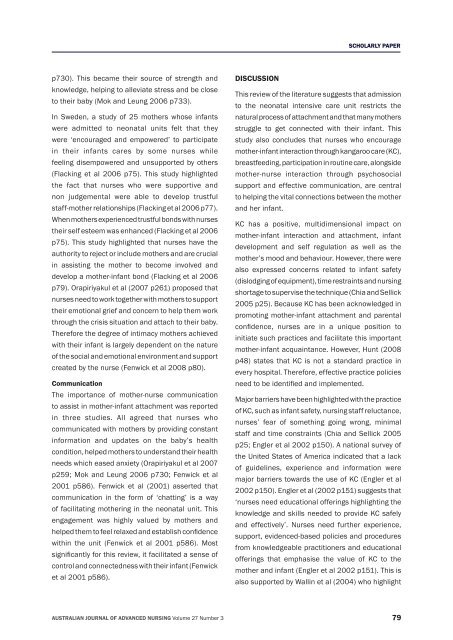March-May, 2010 - Australian Journal of Advanced Nursing
March-May, 2010 - Australian Journal of Advanced Nursing
March-May, 2010 - Australian Journal of Advanced Nursing
You also want an ePaper? Increase the reach of your titles
YUMPU automatically turns print PDFs into web optimized ePapers that Google loves.
Scholarly PAPER<br />
p730). This became their source <strong>of</strong> strength and<br />
knowledge, helping to alleviate stress and be close<br />
to their baby (Mok and Leung 2006 p733).<br />
In Sweden, a study <strong>of</strong> 25 mothers whose infants<br />
were admitted to neonatal units felt that they<br />
were ‘encouraged and empowered’ to participate<br />
in their infants cares by some nurses while<br />
feeling disempowered and unsupported by others<br />
(Flacking et al 2006 p75). This study highlighted<br />
the fact that nurses who were supportive and<br />
non judgemental were able to develop trustful<br />
staff‐mother relationships (Flacking et al 2006 p77).<br />
When mothers experienced trustful bonds with nurses<br />
their self esteem was enhanced (Flacking et al 2006<br />
p75). This study highlighted that nurses have the<br />
authority to reject or include mothers and are crucial<br />
in assisting the mother to become involved and<br />
develop a mother‐infant bond (Flacking et al 2006<br />
p79). Orapiriyakul et al (2007 p261) proposed that<br />
nurses need to work together with mothers to support<br />
their emotional grief and concern to help them work<br />
through the crisis situation and attach to their baby.<br />
Therefore the degree <strong>of</strong> intimacy mothers achieved<br />
with their infant is largely dependent on the nature<br />
<strong>of</strong> the social and emotional environment and support<br />
created by the nurse (Fenwick et al 2008 p80).<br />
Communication<br />
The importance <strong>of</strong> mother‐nurse communication<br />
to assist in mother‐infant attachment was reported<br />
in three studies. All agreed that nurses who<br />
communicated with mothers by providing constant<br />
information and updates on the baby’s health<br />
condition, helped mothers to understand their health<br />
needs which eased anxiety (Orapiriyakul et al 2007<br />
p259; Mok and Leung 2006 p730; Fenwick et al<br />
2001 p586). Fenwick et al (2001) asserted that<br />
communication in the form <strong>of</strong> ‘chatting’ is a way<br />
<strong>of</strong> facilitating mothering in the neonatal unit. This<br />
engagement was highly valued by mothers and<br />
helped them to feel relaxed and establish confidence<br />
within the unit (Fenwick et al 2001 p586). Most<br />
significantly for this review, it facilitated a sense <strong>of</strong><br />
control and connectedness with their infant (Fenwick<br />
et al 2001 p586).<br />
DISCUSSION<br />
This review <strong>of</strong> the literature suggests that admission<br />
to the neonatal intensive care unit restricts the<br />
natural process <strong>of</strong> attachment and that many mothers<br />
struggle to get connected with their infant. This<br />
study also concludes that nurses who encourage<br />
mother‐infant interaction through kangaroo care (KC),<br />
breastfeeding, participation in routine care, alongside<br />
mother‐nurse interaction through psychosocial<br />
support and effective communication, are central<br />
to helping the vital connections between the mother<br />
and her infant.<br />
KC has a positive, multidimensional impact on<br />
mother‐infant interaction and attachment, infant<br />
development and self regulation as well as the<br />
mother’s mood and behaviour. However, there were<br />
also expressed concerns related to infant safety<br />
(dislodging <strong>of</strong> equipment), time restraints and nursing<br />
shortage to supervise the technique (Chia and Sellick<br />
2005 p25). Because KC has been acknowledged in<br />
promoting mother‐infant attachment and parental<br />
confidence, nurses are in a unique position to<br />
initiate such practices and facilitate this important<br />
mother‐infant acquaintance. However, Hunt (2008<br />
p48) states that KC is not a standard practice in<br />
every hospital. Therefore, effective practice policies<br />
need to be identified and implemented.<br />
Major barriers have been highlighted with the practice<br />
<strong>of</strong> KC, such as infant safety, nursing staff reluctance,<br />
nurses’ fear <strong>of</strong> something going wrong, minimal<br />
staff and time constraints (Chia and Sellick 2005<br />
p25; Engler et al 2002 p150). A national survey <strong>of</strong><br />
the United States <strong>of</strong> America indicated that a lack<br />
<strong>of</strong> guidelines, experience and information were<br />
major barriers towards the use <strong>of</strong> KC (Engler et al<br />
2002 p150). Engler et al (2002 p151) suggests that<br />
‘nurses need educational <strong>of</strong>ferings highlighting the<br />
knowledge and skills needed to provide KC safely<br />
and effectively’. Nurses need further experience,<br />
support, evidenced‐based policies and procedures<br />
from knowledgeable practitioners and educational<br />
<strong>of</strong>ferings that emphasise the value <strong>of</strong> KC to the<br />
mother and infant (Engler et al 2002 p151). This is<br />
also supported by Wallin et al (2004) who highlight<br />
AUSTRALIAN JOURNAL OF ADVANCED NURSING Volume 27 Number 3 79

















